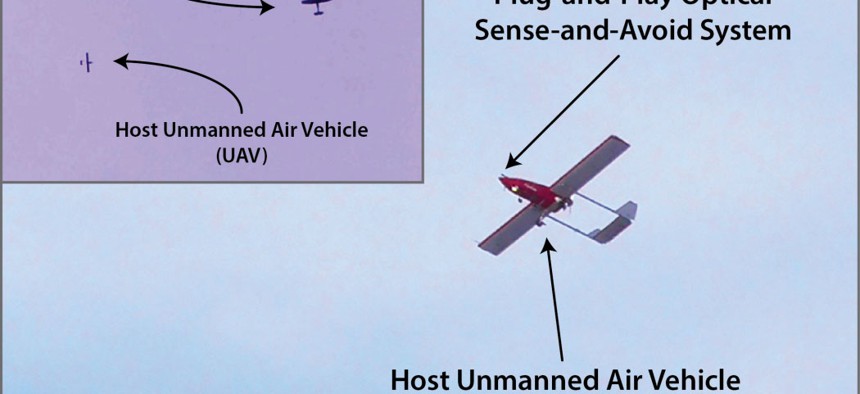DARPA demos sense-and-avoid system
The drop-in ALIAS system, tested in a small drone, helps both manned and unmanned aircraft detect and evade incoming air traffic.
One of the keys for unmanned aircraft operation – especially within the context of greater integration in U.S. national airspace – is reliable sense-and-avoid technology, but manned aircraft also could use a collision avoidance system that helps spot and evade oncoming traffic.
The Defense Advanced Research Projects Agency recently successfully tested a system that can work for both — a shoebox-sized, drop-in system for automatically detecting and avoiding mid-air collisions. The Aircrew Labor In-Cockpit Automation System, or ALIAS, was demonstrated in a UAS, which detected and tracked in real time a Cessna 172G aircraft that approached from several angles.
DARPA’s idea behind the ALIAS program was to overcome challenges associated with complicated interfaces and preparedness during unexpected mid-air emergencies.
The sense-and avoid, or SAA, package includes an optical camera to provide imagery for detection and tracking, and incorporates passive ranging features for assessing incoming aircraft flight paths to successfully interdict and steer clear of.
“This successful flight test is a step toward adding external perception to ALIAS’ toolkit for advancing in-flight automation,” said Dr. Daniel Patt, a Program Manager in the Tactical Technology Office. “What pilot wouldn’t want to set a box on their dashboard that would provide an additional pair of eyes to alert of potential collisions? This SAA system has the potential to enable a wide range of manned and unmanned systems to safely integrate into an increasingly populated and complex airspace.”
Contracts for the first phase of the ALIAS program was awarded last year focusing on three technology areas: 1) development of minimally invasive interfaces between new automation systems and existing aircraft; 2) knowledge acquisition on aircraft operations, to support rapid adaptation of the ALIAS toolkit across different aircraft; and 3) human-machine interfaces that would enable high-level human supervision instead of requiring pilots’ constant vigilance over lower-level flight maintenance tasks.
Additional focus areas included conducting system architecture analyses, system requirements development, trade studies and operational capability definition for an optimized vision.
Future contacts for Phases II and III will be limited to those in prior phases and must meet the standards outlined in a broad agency announcement from DARPA, which expects the entire program to run for 43 months.
Eventually ALIAS envisions a tailorable, drop-in, removable kit to enable high levels of automation in existing aircraft, reducing the need for crews onboard.
The next steps involve another phase of testing to build upon the two-plus years of ALIAS research (as well as 50 years of aircraft automation, DARPA notes), which will include joint funding from the Air Force Research Laboratory. Follow-on research will shrink the size of the system, mature capabilities such as detecting aircraft below the horizon and in poor light, and improve calculations for optimal aircraft trajectories to avert collisions.
In a move that has been floated by many in the UAS world as a potential mandate for all UAS flying in the national airspace, ALIAS research could serve as a line of defense in future layered air traffic management systems with Automatic Dependent Surveillance-Broadcast transponders in line with the FAA’s NextGen effort, DARPA said.




